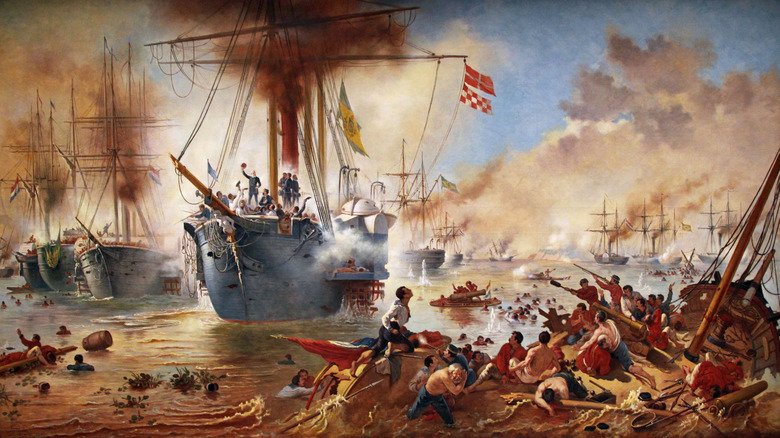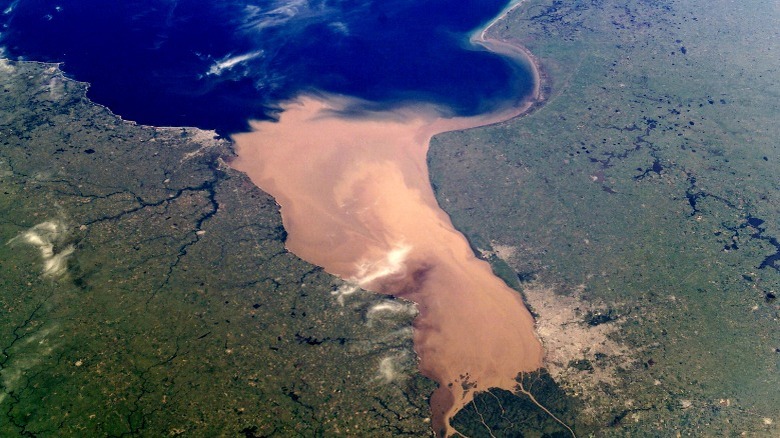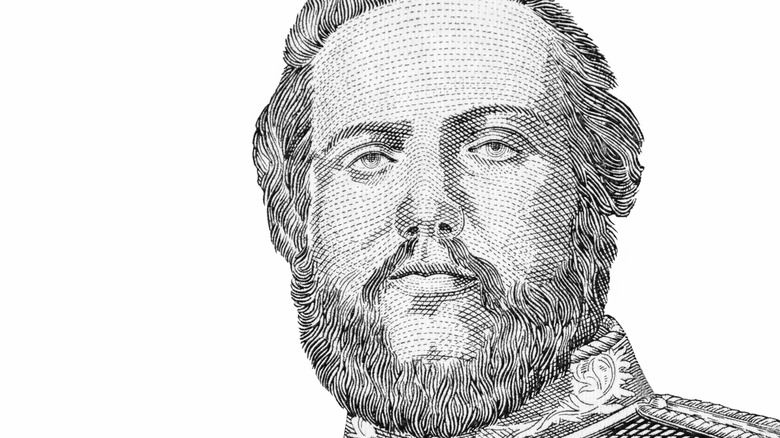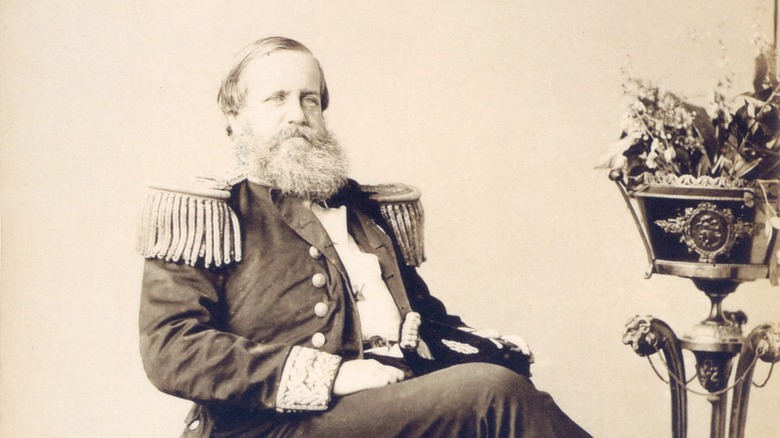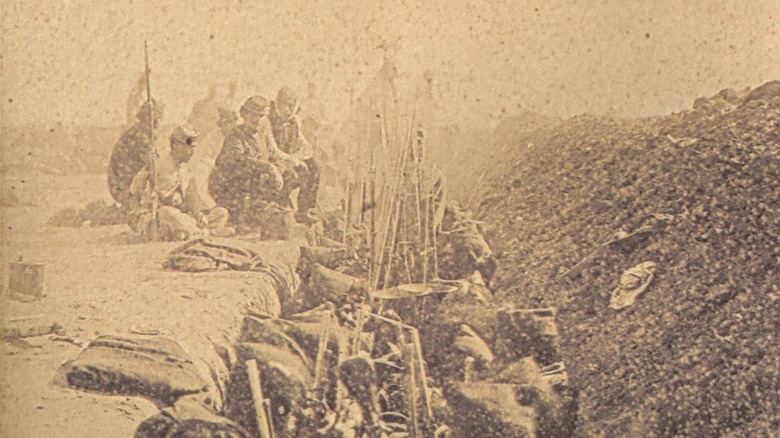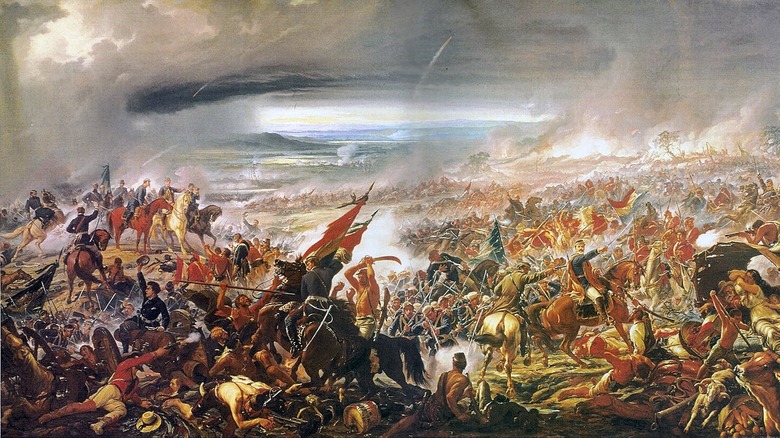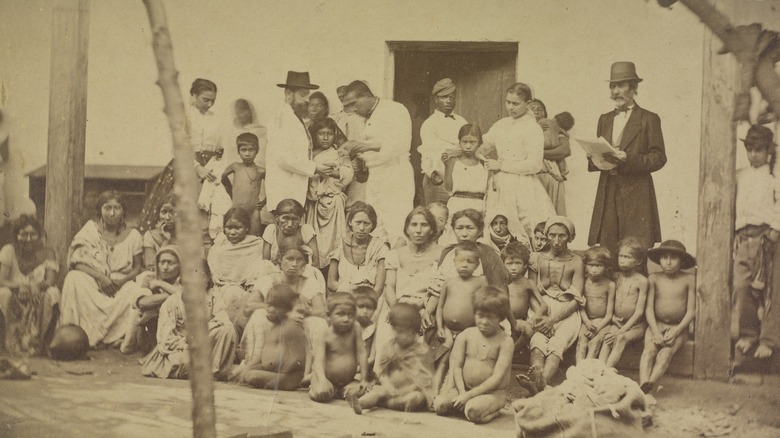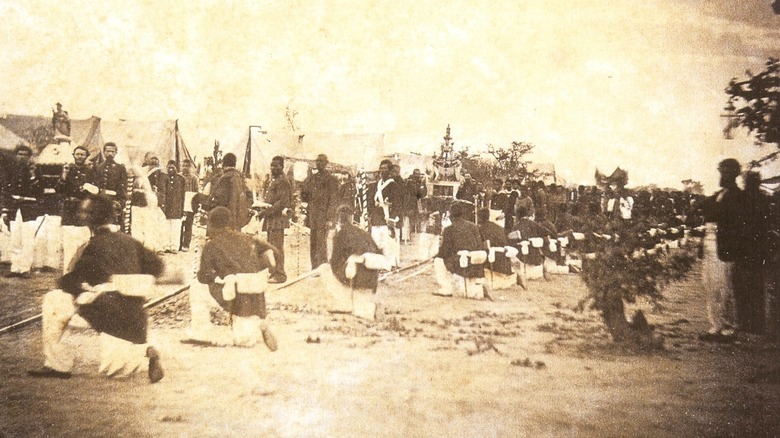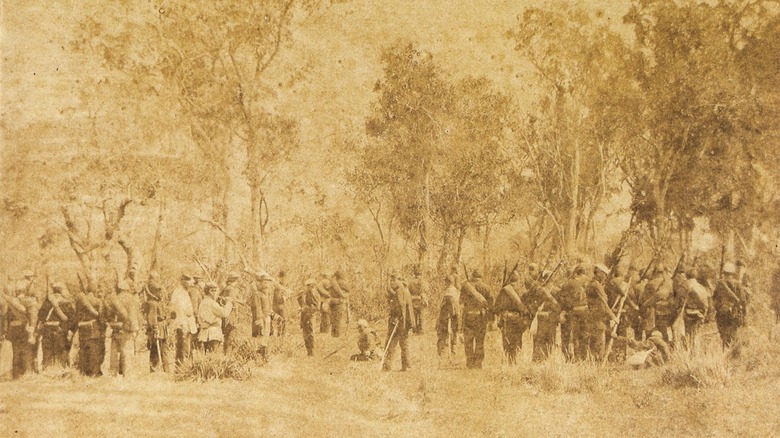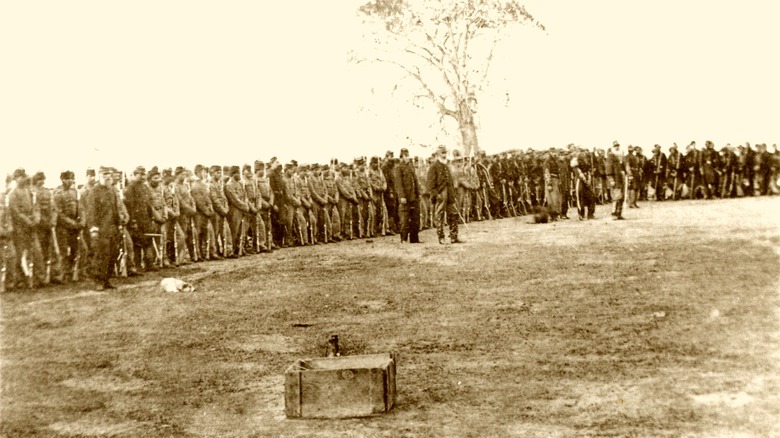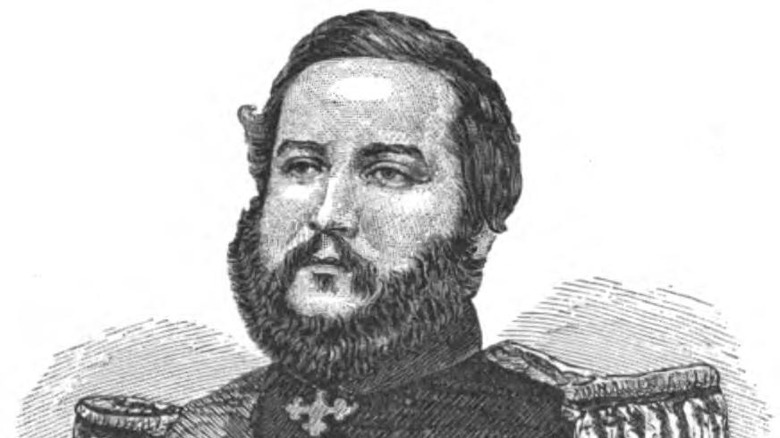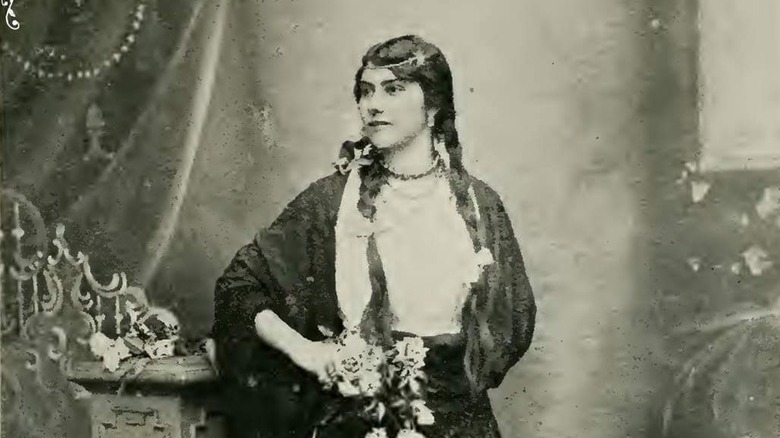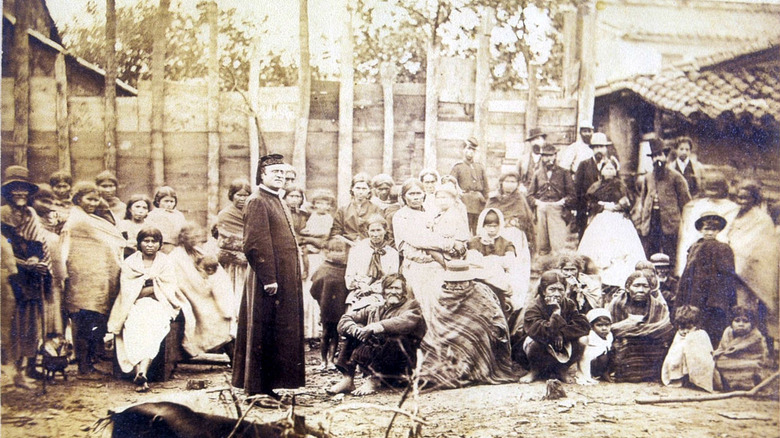Tragic Details About The War Of The Triple Alliance
In the latter half of the 18th century, Latin America was wracked by the deadliest and longest-lived war in the region's history: The War of the Triple Alliance, also known as the Paraguayan War (via "Brazil: Essays on History and Politics"). This brutal conflict saw men dying in thick mud, child soldiers slaughtered, and women working on the front lines. All the countries involved saw massive losses, but the effects on Paraguay were the most devastating of all: According to some estimates, 90% of the male population was wiped out by the war (via The Guardian).
What started as the mad gambit of the vainglorious dictator of Paraguay spiraled out of control, when Brazil, Uruguay, and Argentina made a pact to fight the tiny Latin American nation. The three allies showed the hubristic Paraguayan dictator and his people little mercy — and the Paraguayans kept fighting, despite the dizzying death toll.
The war is rarely discussed in the English-speaking world, but it looms large in the Latin American imagination. The War of the Triple Alliance was the first Latin American conflict to be extensively captured in photographs, and the events of the war went on to inspire countless books, poems, and plays across the region. Here are some tragic details about the War of the Triple Alliance.
Paraguay's powerful neighbors were a existential threat
In retrospect, tiny Paraguay's decision to go to war with its enormous neighbors seems insane, but at the time, it did make a certain amount of sense: The disastrous War of the Triple Alliance was mostly about combating Brazil's growing power in the region.
According to "Brazil: Essays on History and Politics," leading up to the war, Brazil spent most of its time trying to secure access to the Rio de la Plata, which flows into the Atlantic Ocean and has long acted as a crucial vein of trade in the Americas (per Britannica). Following years of conflict, the country of Uruguay emerged as a buffer state along the La Plata River, wedged between bellicose Brazil and Argentina. However, by the mid-19th century, Brazil began to interfere in Uruguay's affairs (via "Logics of War").
Little Paraguay, also trapped between Brazil and Argentina — both of whom were far larger – was understandably jumpy about all this, not least because it also had an ongoing border dispute with Brazil (via Britannica). Paraguayans were worried that their country could be destroyed by their more powerful neighbors one day, and like everybody else in the region, they were worried about maintaining access to the rivers that run from Paraguay into the La Plata (per "Logics of War"). After Brazil interfered in Uruguayan politics by backing its liberal Colorado Party, the dictator of Paraguay threw all caution to the wind and attacked Brazil.
Paraguay's dictator was unhinged
Prior to the War of the Triple Alliance, a dangerous situation was bubbling away between Uruguay and Brazil (per Britannica), which most level-headed leaders would have kept at arm's length. However, Paraguay's new dictator at the time was an unusually ambitious and self-obsessed military man with a love of warfare.
Although he is a hero to some, President Francisco Solano López is quite often characterized as a delusional psychopath — and with good reason (via the Library of Congress). López was known for his cruelty — during the war, he had his brothers killed, and his mother and sisters tortured. Saddled with a paper-thin ego, he frequently jailed his critics and severely punished women who turned down his advances. López's vain personality has been blamed for his astonishing decision to invade Brazil.
López spent a great deal of time in Europe as a young man, and he was particularly enamored with the flashy court of Napoleon III (per "The Paraguayan War"). His love of Bonapartism soon became legendary, and while abroad, he obsessively researched the French military and their techniques. When he came home, he modeled his own armies on modern European lines, and to his credit, he did an appreciable job of reforming the Paraguayan military. Nonetheless, historians believe López hugely overestimated his country's military capabilities, spurned on by blind ambition.
Paraguay ended up fighting three countries at once
Despite Francisco Solano López pushing for military reform, any advantage he gained from his well-organized troops was undermined by the massive numerical superiority of his foes. In 1864, after Brazil invaded Uruguay, López captured a Brazilian warship, then invaded Brazil itself (via the Library of Congress). Further compounding his misjudgments, he then made the absolutely insane decision to invade Argentina as well, after the Argentine government refused his army right of passage through their territory to attack Brazilian forces. Subsequently, Brazil, Argentina, and Brazil-controlled Uruguay all declared war on the power-hungry dictator (via Britannica): Their collective forces are believed to have outnumbered López's by ten-to-one.
After an initially strong start, the Paraguayans were inevitably forced to withdraw, and by 1866, they were the ones being invaded. Paraguay was forced to conduct a defensive campaign it was destined to lose. Although López benefited from his successful military reforms and a large army, he did not have much in the way of material resources or military leadership to keep the war going.
Ironically, historians now believe that it is highly unlikely that Argentina and Brazil — both otherwise distracted — would have ever bothered to attack Paraguay, if López had not gone on the aggressive (via the University of London).
Troops fought bloody battles in swampy water
Due to its boggy terrain, Paraguay is one of the worst places imaginable to fight a ground war: Scattered marshlands surround the Paraguay and Paraná rivers that flow through the region, and regular floods routinely drown large parts of the country (via "The Paraguayan War").
The largest and most terrible battle of the war took place on an open floodplain (via Warfare History Network). Having surged into Paraguayan territory, the allied forces met Francisco Solano López in the muddy wetland at the Battle of Tuyuti in 1866. López foolishly decided to charge at the invaders rather than staying put, forcing his troops to walk into the gunfire across the swamp. The Paraguayan soldiers were mowed down as they slowly slogged through the difficult terrain: Around 7,000 Paraguayans were killed in a single day, and a staggering 10,000 were wounded (via Pesquisa FAPESP).
The horrifying conditions made the fighting that much more difficult, and it wouldn't be the last time troops were forced to fight in a marsh. During their campaign to capture Humaita, for example, the allied nations' soldiers waded through deep swamp water that came up to their chests. The flood waters would badly damage troop morale and had terrible consequences for the soldiers' health.
Disease killed thousands of troops
On the allied side, the unsanitary conditions that troops lived through during the war killed more soldiers than the war itself: According to some estimates, 70% of allied casualties were caused by illness (via Pesquisa). The swampy wetlands attracted mosquitos and therefore malaria, and piles of corpses left to rot in Paraguay's waterways contaminated the drinking water. The charnel house the troops left behind also attracted scores of insects, rodents, and vultures.
The lack of sanitation also caused frequent cholera outbreaks, and deadly smallpox swept the country during the war, at a time when many people had still not been vaccinated. Measles and yellow fever were also common causes of death, and syphilis spread through the ranks — then attributed to women being present among the camp followers. On the Argentine side, 12,000 people died of cholera alone (via the University of London).
Those who weren't killed by the disease often simply died of exposure: A lot of the soldiers did not have appropriate clothing for the long winter months they spent hunkered down in muddy trenches.
Many women were heavily involved in the war
Paraguay's war quickly devolved into a fight for survival that dragged on for many years, per Britannica. Anyone who could provide any assistance was roped into the war effort, and women played an unusually large role in the conflict. Many Paraguayan women spent their days manufacturing military uniforms, and sent their pots and pans to be melted down to make bullets and cannonballs (via The Americas). After the president asked women to trade their jewelry for patriotic colors, thousands of wealthy women also donated their gold and jewels to the war effort (via the BBC).
Other women followed the army itself, working as nurses, carrying arms, and digging trenches for the soldiers. These women did not receive payment for their work but arrived voluntarily to help their brothers and sons. The bravest — or perhaps the most desperate — fought in the front lines with the men. Short on guns, they were often forced to arm themselves with glass bottles rather than rifles.
Not all the women of Paraguay embraced patriotic fervor. The war had not only made many women widows, it also forced many destitute women into sex work to support themselves. And by 1868, a group of thirty women — nicknamed the "destined ones" — were among those associated with a plot against the president, and were severely punished.
Brazil used enslaved people to fight for them
The scale of the War of the Triple Alliance forced Brazil to massively enlarge its army to around 130-150,000 men (via the University of London). To lessen the burden on Brazil's free populace, the state sent many enslaved Black Africans to die in their stead.
Enslaved people were often offered a choice between enslavement and enlistment, and many chose to fight for a chance at freedom (via Slavery and Abolition). Some enslaved people were "donated" by patriotic enslavers, while others ran away to join the service. In a few cases, men offered up enslaved people in place of themselves to get out of fighting altogether.
While this arrangement did give enslaved people a shot at freedom, some of the logic underlining the measure was deeply disturbing. One politician at the time commented that it was better to risk the lives of Africans, whom they considered potentially dangerous, than risk the lives of "civilized" free Brazilians. On the plus side, the role of enslaved people during the war hastened calls for abolition in the country after the conflict ended: Important anti-slavery legislation was passed not long after Paraguay's defeat in the 1870s.
Francisco Solano López didn't give up after losing
The War of the Triple Alliance should have ended far earlier than it actually did. However, Brazil was in no mood to forgive the hated Paraguayan President, even when the bulk of his army had been destroyed in December 1868 (via Brazil: Essays on History and Politics). Brazil refused to conduct any peace negotiations and would not accept any terms on any conditions, even when international observers tried to intervene to stop the slaughter (via "Logics of War"). Instead, Francisco Solano López was declared a monster and a tyrant who needed to die.
What followed was over another year of fighting that led to some of the most brutal battles of the war, as López resorted to guerrilla tactics to save his skin (via Warfare History Network). During this late stage of the conflict, López began to lash out at anyone and everyone in a fit of paranoia. Foreign residents living in Paraguay were executed en masse, and not even diplomats were spared.
Paraguay's now shattered army was replaced by women and children, forced to serve as human shields while López fled the hunting parties out for his blood. Allied soldiers repeatedly came across ramshackle bands of women and 14-year-old boys they were reluctant to fight, and they cut them down with ease.
Children were forced to fight at the Battle of Acosta ñu
One of the worst catastrophes of the war occurred in August 1869, at the Battle of Acosta ñu, when 20,000 Brazilians faced off against 3,500 Paraguayans (via the BBC). In a shameful act of cowardice, Francisco Solano López had fled the area just a few days before, leaving behind him a garrison of women, children, elderly men, and a few soldiers.
The child soldiers who fought at Acosta ñu were aged between 9 and 15 years old, and many of them had been given fake beards and mustaches to disguise their age. Others had been given sticks to hold like rifles. The soldiers who fought on the allied side were deeply shaken by the presence of the children among the ranks, and accounts from the time record that many of the recruits were deeply regretful about the battle. One Brazilian general wrote, " ... we felt great sorrow, due to their sheer number, the little soldiers, covered in blood, with broken legs, some of whom had not even reached puberty ..."
Not a single Paraguayan survived the skirmish, and an estimated 700 children were shot that day by Brazilian soldiers. In present-day Paraguay, Children's Day on the 16th of August commemorates the atrocity at Acosta ñu, and honors the children for their bravery (via UNESCO).
Francisco Solano López was killed while fleeing
After a tragic defeat at Acosta ñu in mid-1869, Francisco Solano López kept running for another six months (via the University of London). Allied troops finally caught up with him in 1870, in the subtropical forests of Cerro Corá (via The Guardian).
Although his remaining soldiers stood their ground and fought, López, who had been wounded by a spear, tried to make another break for it by jumping into the Aquidaban River (via Warfare History Network). While halfway across, he was shot in the back of the head and finally perished. According to legend, his last words were, "I die with my homeland!" After over five years of conflict, the longest war in Latin American history was finally over — with very little of Paraguay left intact.
While you might be forgiven for assuming that López is hated in Paraguay for his reckless actions — in truth, he has often been held up as a hero. Paraguay's dictator Alfredo Stroessner, who ruled the country from the 50s to the late 80s, rehabilitated López as a heroic underdog, and his face can be found on the local currency today.
The President's girlfriend was blamed for the war
Bizarrely, during and after the war, some people blamed Francisco Solano López girlfriend, Eliza Lynch, for encouraging the dictator to start the terrible conflict in the first place. Lynch was an Irish national who started a relationship with López after she met him in Paris, and she became a glamorous but controversial celebrity in Latin America (via The Guardian).
Lynch caused a stir among conservatives in particular because, although she never attained a divorce from her French husband, she gave López seven children out of wedlock (via the Dublin Review of Books). Lynch's European attitudes and tastes were highly influential, but she was roundly condemned as a sex worker (via Independent.ie). While it is true that Lynch was pretty fond of partying, there is no proof she was ever involved in sex work.
Thanks to wartime propaganda created by the allied press, many people came to believe that Lynch had convinced López that he could become some sort of Latin American Napoleon, and she has been slandered as a wicked warmonger all the way up to the present day. In truth, in the final bloody days of his presidency, Lynch was as scared of López's violent behavior as anyone else. She remained with López until his final moments, burying the dictator with her bare hands in the forest where he fell.
Paraguay was left in ruins
By the end of the war, Paraguay's territory had been reduced by 40%, and a large chunk of its infrastructure had been destroyed (via the University of London). Paraguay was occupied for another 10 years and forced to pay reparations to Brazil until after World War Two.
Worst of all, Paraguay's death toll was catastrophic. The exact figures are still up for debate, but even the most conservative estimates are massive; many researchers believe that somewhere between 50-70% of the adult population was wiped out by the war (via Paraguay's ABC News). Many of those not killed in battle also left Paraguay by choice, or became refugees.
The most somber estimates put the male death toll at a shocking 90% (via The Guardian). Although this figure may be an exaggeration, census data collected soon after the war confirms that women outnumbered men in Paraguay by four to one in most places, and as much as twenty to one in the worst affected areas. The sweeping social and economic upheavals caused by the War of the Triple Alliance crippled Paraguay for many years, and are still felt in the 21st century.
